
Japan’s influence in Los Angeles is palpable: the sheer amount of sushi restaurants in the San Fernando Valley, the perennial Little Tokyo district, and historic restaurants that are still brimming like Otomisan, the first LA Japanese restaurant opened in 1956 in Boyle Heights. However, many people would be surprised to know that the South Bay was actually the first Japantown in LA.
According to Wikipedia, Gardena and its neighboring city, Torrance, have the highest percentage of Japanese Americans in California, as well as the highest concentration of Japanese companies in the United States.
Why did Japanese immigrants settle down in the South Bay?
Post-World War II settlement and the automotive industry, particularly Toyota, which established its US headquarters in Torrance in 1984. Additionally, many Japanese fishermen worked in San Pedro, and the South Bay offered cheap land. Even before World War II, many immigrant farmers put down roots in the South Bay because it was one of the few places in Southern California that leased land to non-US citizens.
In 2014, after 30 years in Torrance, Toyota relocated its US headquarters from Gardena to Plano, Texas. Nissan uprooted its Torrance headquarters to Franklin, Tennessee, in 2006.
Although these areas are no longer the same thriving hubs as they were 40 years ago for Japanese newcomers, the Japanese presence is still very alive.
If you drive around this suburban galore, you’ll inevitably come across a slew of Japanese supermarkets, churches, schools, banks, and restaurants. One of them is a tiny hole-in-the-wall sushi shop that has been serving the same sushi pieces since 1962, Sakae Sushi.

The shop, which operates as a walk-up window, was founded by husband and wife Aya and Sumizo Tani in 1962. This is not your average sushi shop slinging nigiri sushi, sashimi, tempura or miso soups. The menu consists of three rolls—Tamago, Nori-Maki, and California—and three sushi pieces—Inari (deep-fried tofu), Ebi (shrimp), and Saba (pickled Mackerel).
The California roll was added in 1980 by Aya’s daughter, Etsuko Tani.

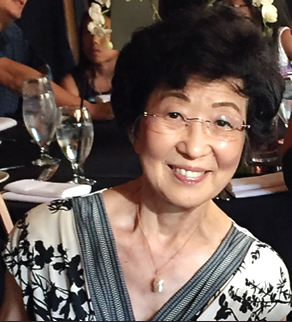
Over the years, Sakae Sushi has become one of the most celebrated Japanese restaurants in Gardena. Etsuko credits the extended family for keeping the restaurant alive, rooted in the same traditional recipes since they opened.
Despite the heaps of praise, the shop wasn’t very successful in 1962. In the 2023 LA Times article, “This South Bay Sushi Shop Has Been Serving the Same Six Items for Decades“, by Lucas Kwan, Etsuko’s daughter Emi said: “My grandparents were pretty amazing to start something like sushi in the ’60s in an area where it was not the norm. No one was really selling it.”
During its beginning stages, Aya and Sumizo opened Sakae Sushi as a restaurant with two tables, but for the most part, Sakae Sushi has operated as a takeout establishment.
At only 11 years old, Etsuko moved from Kumamoto Prefecture to LA with her mom Aya in 1954. Aya worked at ABC Nursery in Gardena and sometimes she’d bring sushi to the workers, using the recipes she learned as a young girl growing up in the fishing village of Uragami, located in the Kansai region. She loved making people smile through her food.
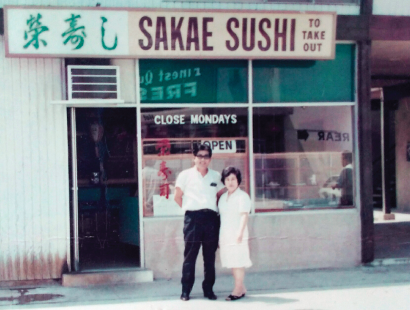
Workers at ABC Nursery would tell Aya how good her sushi was, so she started selling it at Motomaya Market on 162nd and Western Avenue. Eventually, she’d open Sakai Sushi. Sixty-three years later, her daughter Etsuko continues carrying on the family tradition with her three children: Emi, Jeff and Jason; her sister Sugako and brother-in-law Joey.
Everyone contributes to the shop’s success: Emi takes orders over the phone, Jeff preps the rice, Jason takes care of the fish and Etsuko presses and assembles the sushi.

Most Japanese restaurants use a rice cooker, but that is not the case at Sakae Sushi. Cooking rice the old-fashioned way, on a stove, is the way to go.
Emi said to the LA Times: “None of us own a rice cooker at home. That’s how we grew up, it’s all we know. It just tastes better.”
In the 2018 Rafu Shimpo article “Sakae Sushi – A Tradition of the Season”, by Gwen Muranaka, Emi said: “We’ve stayed with the same vendors that my grandparents started with, the same ingredients. We didn’t change anything, we try to keep it all the same.”
Etsuko attended Hollenbeck Middle School in Boyle Heights. After graduating from high school, she went to beauty school to become an esthetician and shortly after, she met her husband Tom through her aunt. After marrying in 1970, they moved to Gardena, where Tom ran a liquor store in Lawndale. When he was diagnosed with brain aneurysm, Etsuko quit beauty school to take care of him.
In 1981, Etsuko took over Sakae Sushi while also raising three kids, taking care of her ailing husband and elderly parents. Tom passed away at 64 years old in 2007. His brother Joey has been working at the shop for more than 30 years.
If you’re thinking of making the trek to Gardena, it is highly recommended to call ahead to place your order. I had to call a few times before talking to Emi. If the line is busy, just be patient and try again. Sakae Sushi does not work with third-party delivery apps and they don’t have Instagram or email. If you show up without a heads-up, they might be sold out of a certain sushi or you may have to endure long wait times.
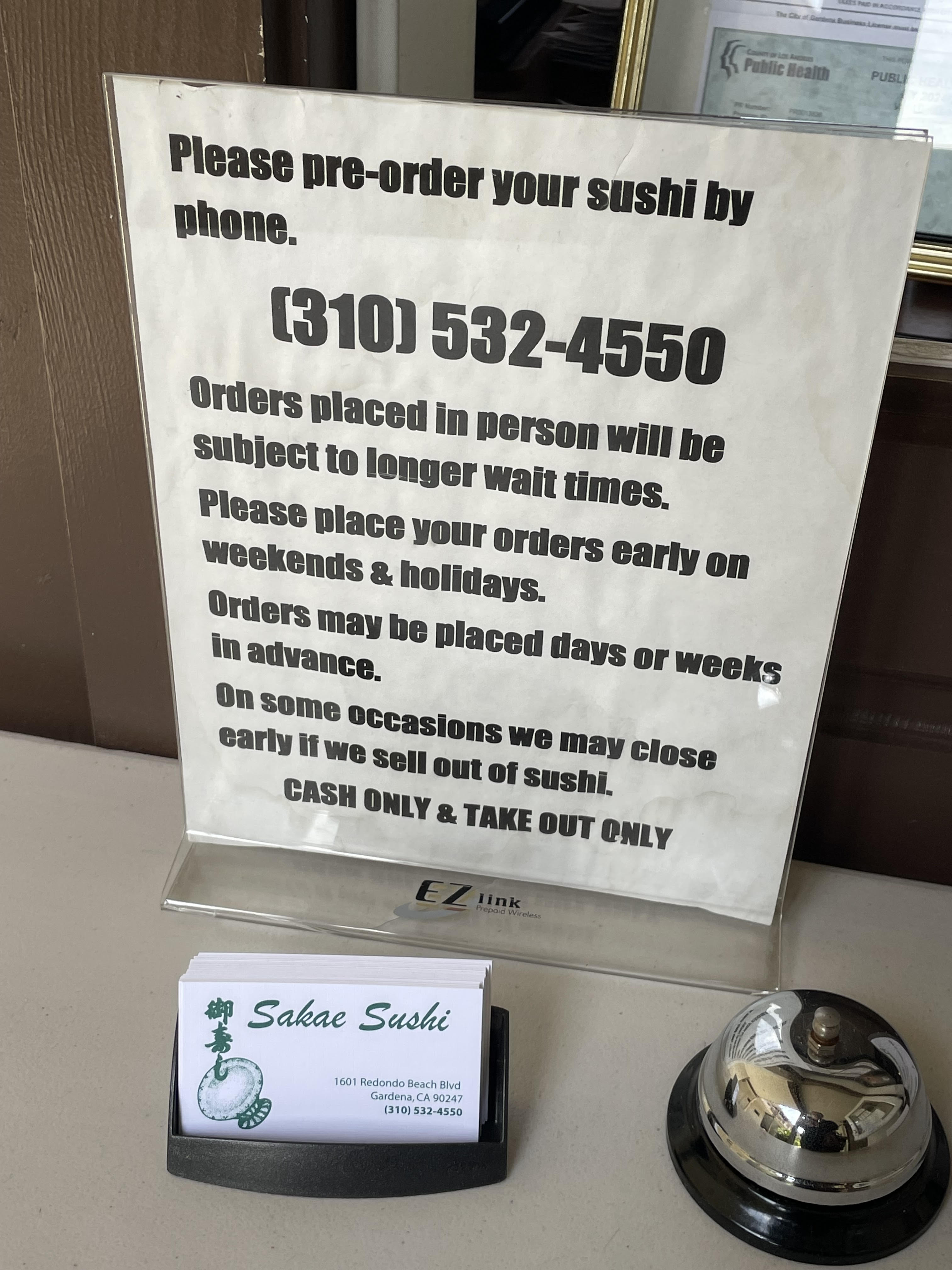
When you finally get through the line, you order the number of pieces based on how hungry you are. “Is it just for you? If it’s just for you and you’re not really hungry… I think 8 is fine,” said Emi on the phone. I ordered a mix of different pieces and since it was my first time, I gave her free rein.
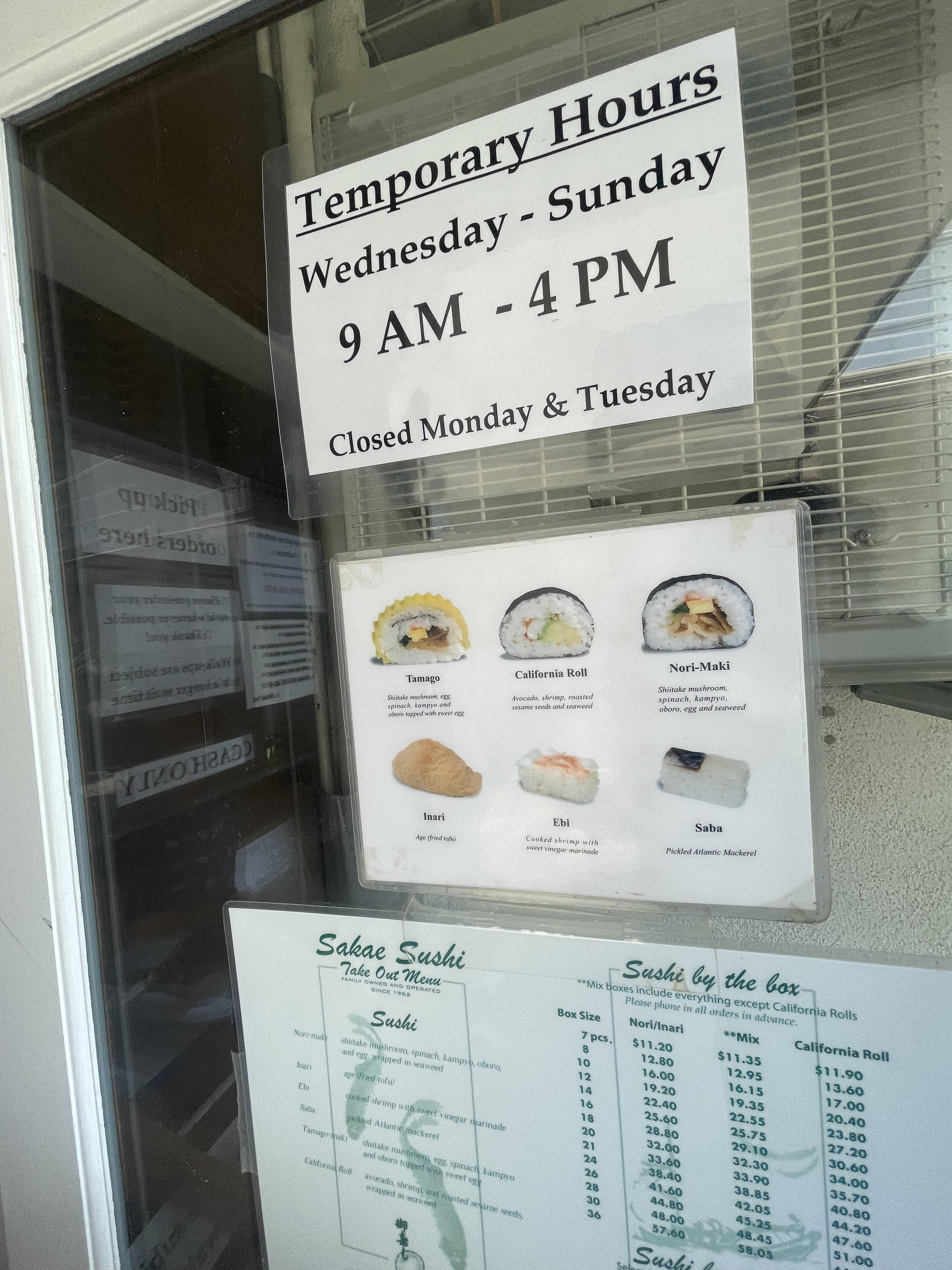
It took me an hour to get to Gardena from Century City on a Friday afternoon, driving through the seemingly never-ending sprawl of strip malls and residential streets after beating the bumper-to-bumper traffic on the 405 – but I made it before 4. I called to let them know that I was running a little late. “It’s fine”, said Emi. “I’ll just put a note”.
When I made my way from my car to the shop, a white nondescript door with a sign that read “Japanese TV Movies” caught my attention. I got a peek through the ajar door of an elderly man enjoying a movie on a TV surrounded by fully-stocked racks of DVDs.
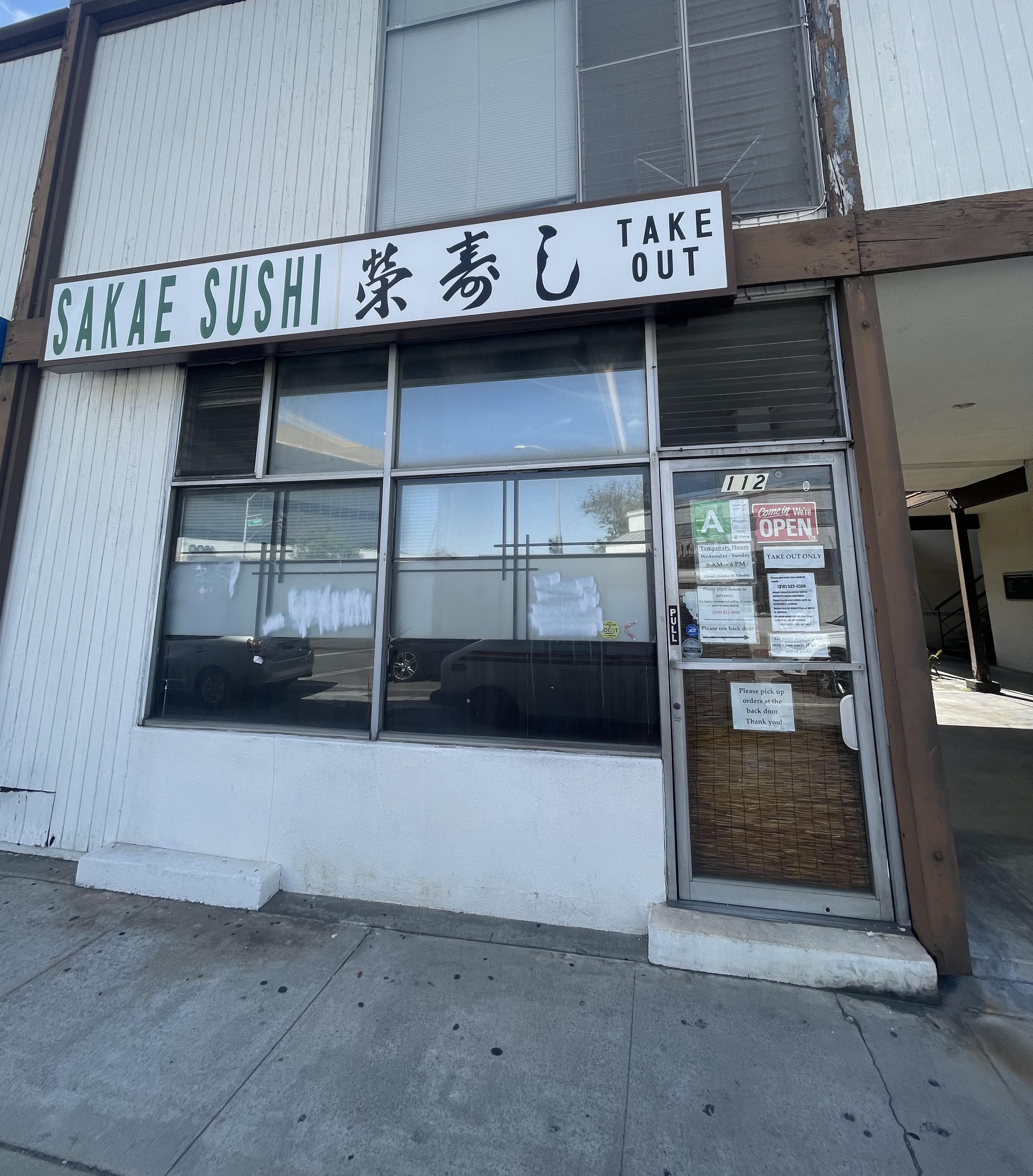
As I kept walking, I found myself in a calming courtyard, where I found Etsuko manning the counter behind a curtain at the walk-up window. She asked for my name and proceeded to hand me my order.

In a world where sushi is thrown into styrofoam containers with grass dividers, Sakae Sushi packaging stands out for its orderly presentation. A paper displaying the logo is wrapped around a cardboard box, neatly tied with green string holding the chopsticks. You would think you were picking up pastries from a fancy bakery.
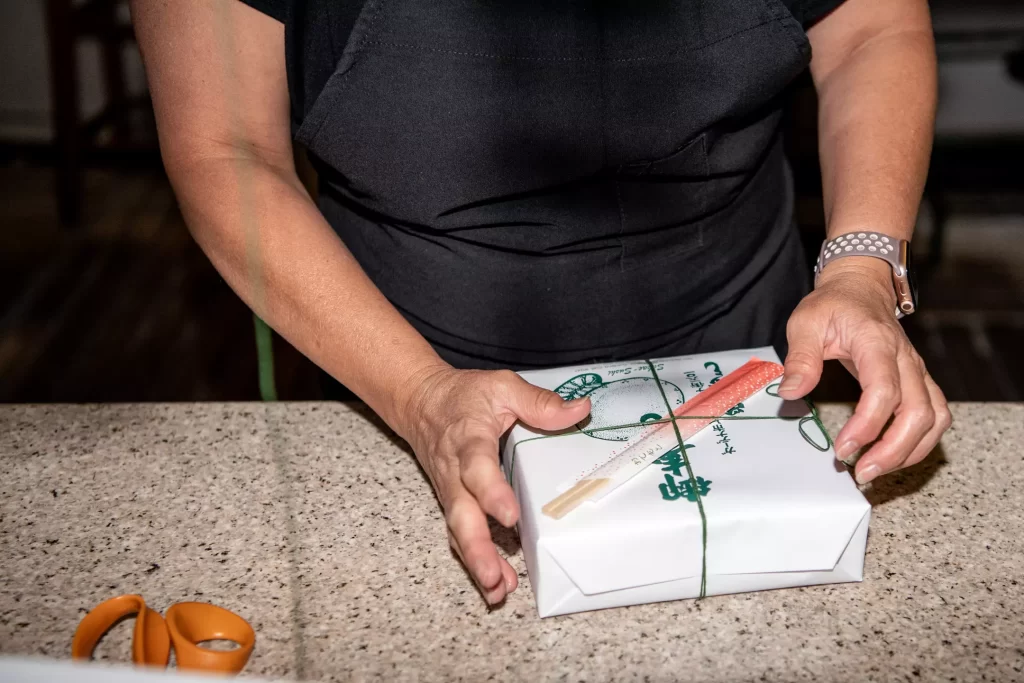
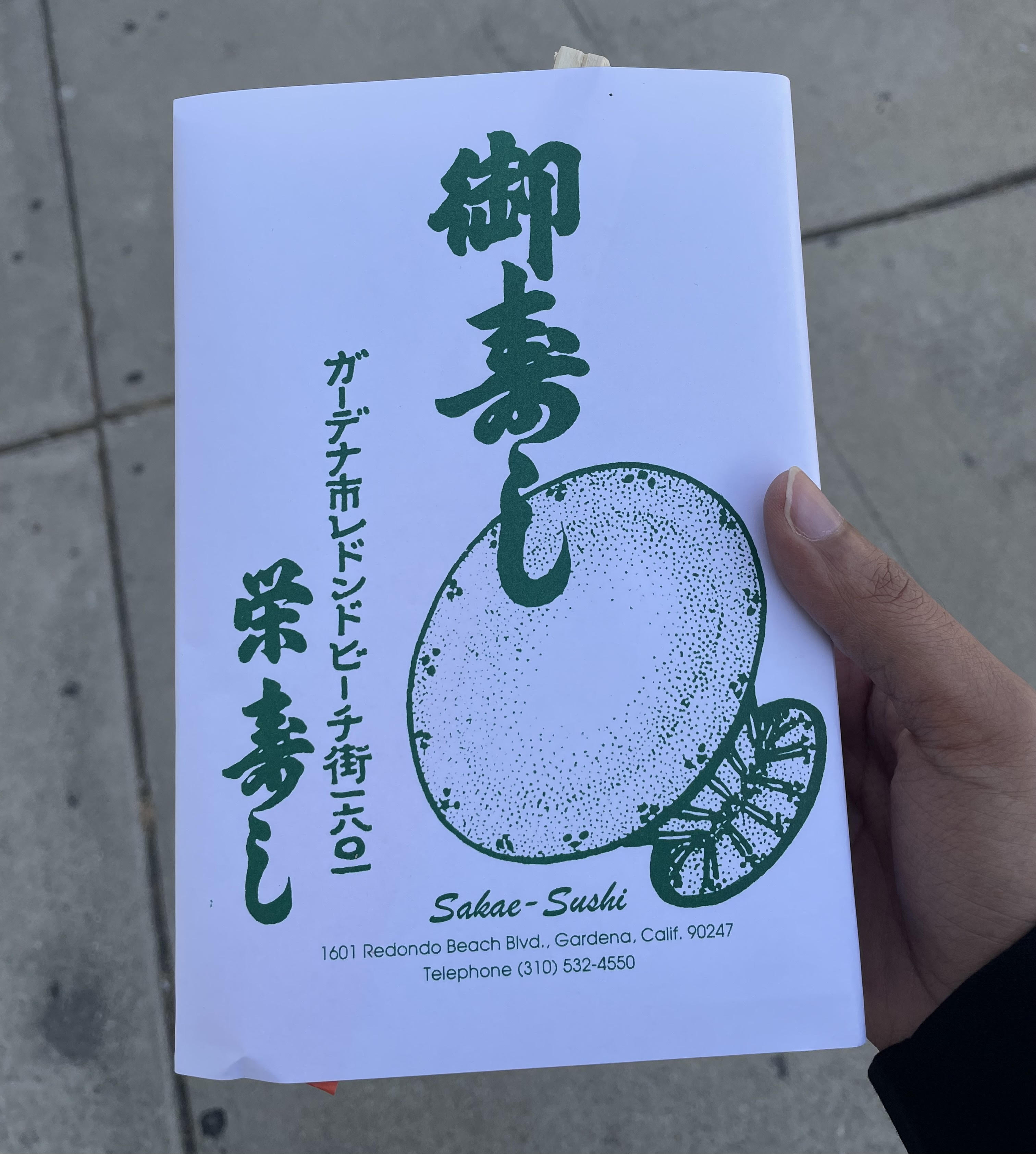
Sakae Sushi doesn’t offer drinks or water and it’s CASH ONLY, so make sure you come prepared. My total for the 8 pieces was about $13, which is an incredible value for the quantity and quality.
Sakae’s sushi is Kansai-style (oshizushi), which is typical in Japan’s Kansai region. It’s also one of the oldest types of sushi. The Tokyo-style sushi (Edomae) that most of us are accustomed to dates back to the 18th century, whereas Kansai-style sushi harkens back to 300 BCE.


In Kansai-style sushi, the ingredients are often prepared to complement the rice by using more sugar and vinegar. The pressed method prevents moisture breakage and allows the firm rice to have better preservation, so even if you eat it an hour later, the rice won’t lose its freshness.

I’ve seen that many people who aren’t familiar with this type of sushi complain about the high rice-to-fish ratio. A few reviews about Sakae Sushi read, “There’s just too much rice!” but the beauty of Kansai-style sushi lies precisely in the fermented rice. Historically, that’s how sushi was eaten before the 18th century.
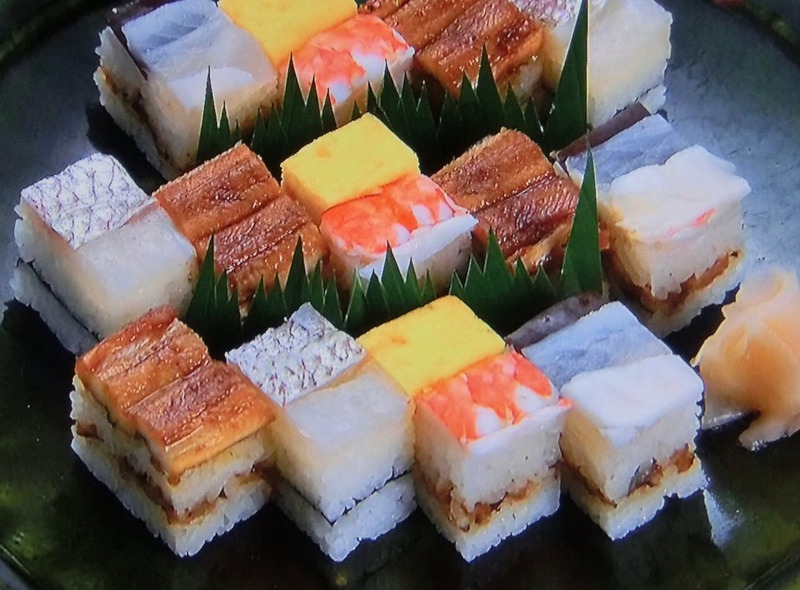

On the contrary, in a Tokyo-style nigiri, the plump rice is lightly seasoned to enhance the fish; so if you were to eat the nigiri two hours later, the rice will be dry. It’s for this reason that Sugarfish doesn’t do nigiri takeout orders, as their rice is meant to be eaten right away.
Many Japanese Americans grew up eating Kansai-style sushi. In the 2018 Rafu Shimpo article, “Sakae Sushi – A Tradition of the Season”, author Gwen Muranaka said:
“For Japanese Americans, the flavors evoke the sushi that we grew up with. It isn’t the fancy, expensive sushi served at so many restaurants today; it has a homey taste that evokes family gatherings, celebrations and summer picnics.”
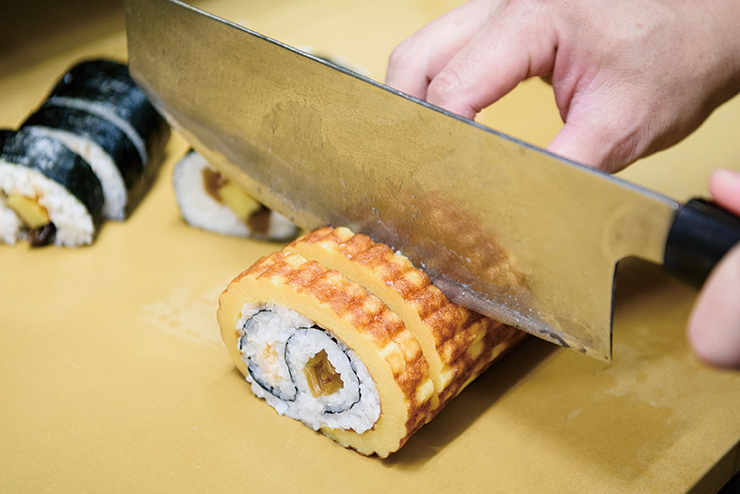
At Sakae Sushi, soy sauce is available upon request, but the fish and the rice are already generously seasoned. The LA Times author said, “I recommend against using it with the sushi; it doesn’t need it.”
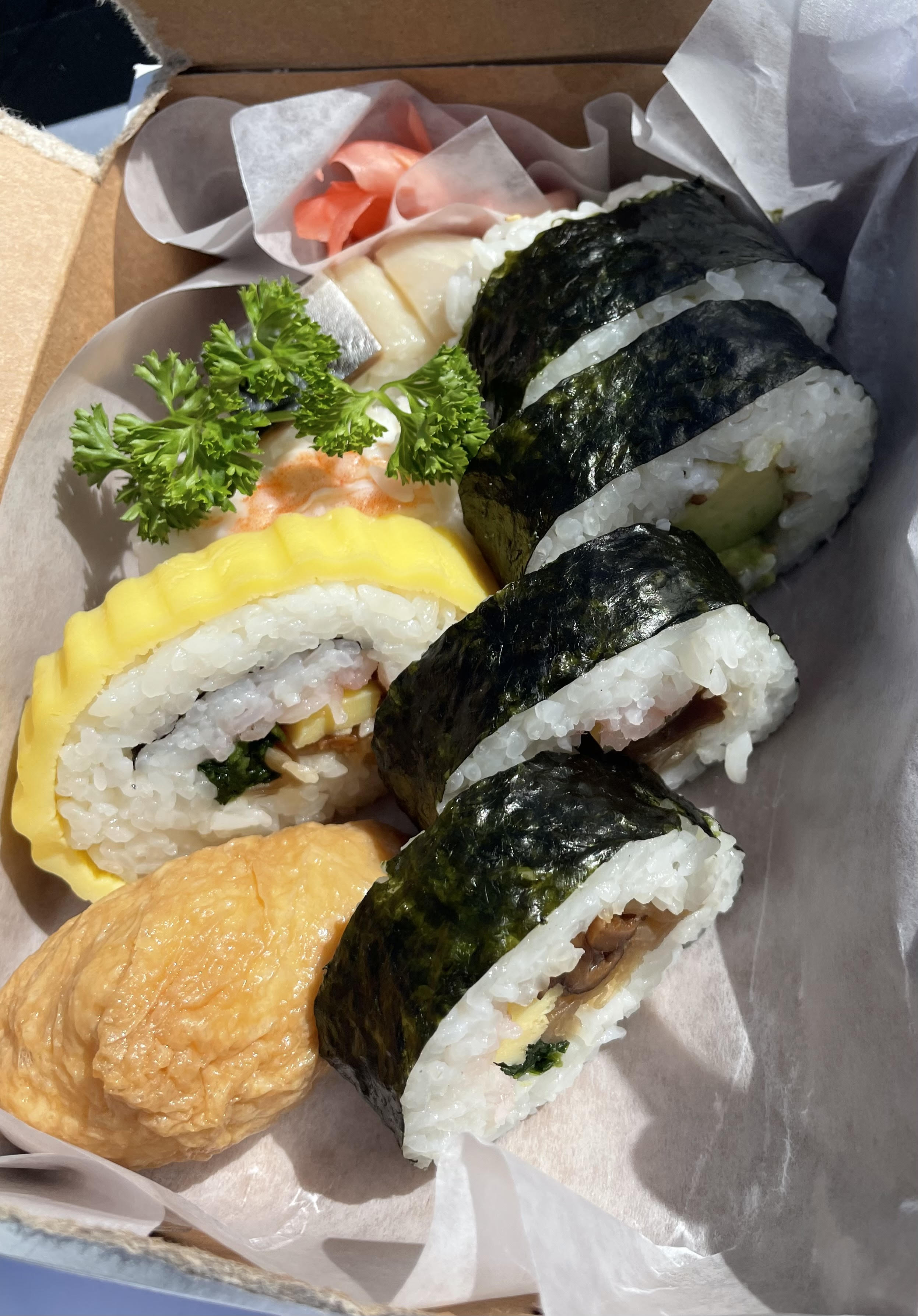
Saba: Glistening flaps of briny mackerel that flawlessly absorbed into the firmly pressed vinegary rice. This was my favorite of all of them.
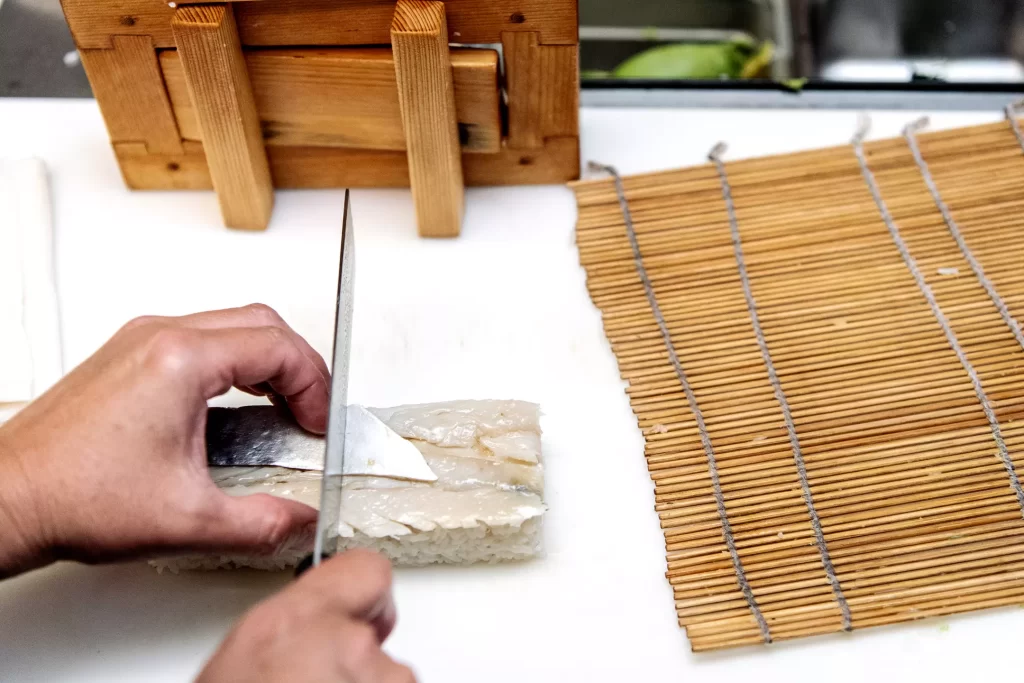
Inari: Some claim that Sakae Sushi has the best inari in LA. In this sushi, the rice is enveloped in deep-fried tofu pouches with sweet and salty seasonings.
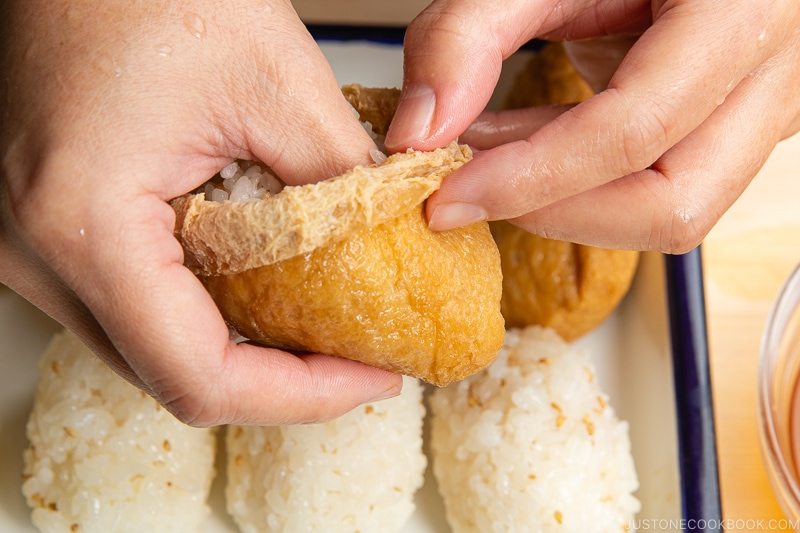
From what I’ve read so far, oftentimes the dried inari is too sweet and too processed, especially if it comes from a grocery store. Despite its wrinkly appearance, Sakae’s inari was slightly moist and silky-soft to the palate, exuding a pleasant mix of sweetness and bitterness – delicately holding the pressed rice. I could even make an indentation on the thin pouch as I held it with the chopsticks.
Tamago roll: In most restaurants, the tamago (Japanese omelette) is on top of the rice and wrapped with a piece of nori. The Kansai-style version is more intricate as the beaten egg is in a thin, ridged shape encasing the rice.
Tamago is no easy feat as it requires a lot of practice, including having the right pan and using the exact amount of dashi (cooking broth). I’ve never been crazy about Japanese omelette, but I’m still thinking about the egg in Sakae’s tamago, with its slightly sweet flavor and ridged yet soft texture.


Nori-Maki: An identical tamago roll minus the egg: shiitake mushroom, spinach, egg, kampyo, paste shrimp. The standout was the slightly sweet and chewy shiitake mushroom, complementing the vinegary rice and the crisp umami flavor from the nori.
California roll: An excellent old-school California roll. The highlight was yet again the firm, tangy rice that held the fresh chunks of avocado and shrimp – Just perfect in every bite. Sakae Sushi is one of the few places in LA that uses shrimp in place of imitation crab.
Ebi: The ebi lacked the boldness of flavor from the other pieces. Unless it’s bathed in a flavorful marinade, shrimp itself is very muted and light. I did like the tenderness of the slices and the simple, sweet vinegar seasoning.
The pink pickled ginger, coupled with the pressed seasoned rice, is a match made in heaven. Don’t overlook it. Also, make sure you bring water to wash it all down.

I made my way back from my car for a piece of saba and tamago. Etsuko wasn’t too surprised when she saw me coming back for seconds, and even burst into laughter when I told her how good everything was. They were out of the tamago rolls for the day, but she encouraged me to order the nori-maki, which had the same filling as the tamago. However, I wanted the tamago for no other reason than the incredibly funky-shaped egg. So, I ended up ordering two pieces of saba.
Etsuko wrote down my name in Japanese and disappeared for a moment. While I was waiting, Emi popped out for a second and warmly welcomed me. “Hi! We talked on the phone”, she said.
If there is something else to highlight at Sakae Sushi, it’s their exceptional customer service. Nice is a big understatement. They were so kind that I felt like I was being welcomed into their house. It’s no wonder Gardena loves this family!
When Emi gave me my order, she said they had more fish left, so she gave me an extra piece of saba. She offered me soy sauce, but upon asking her, she didn’t really recommend it, especially with this type of fish.
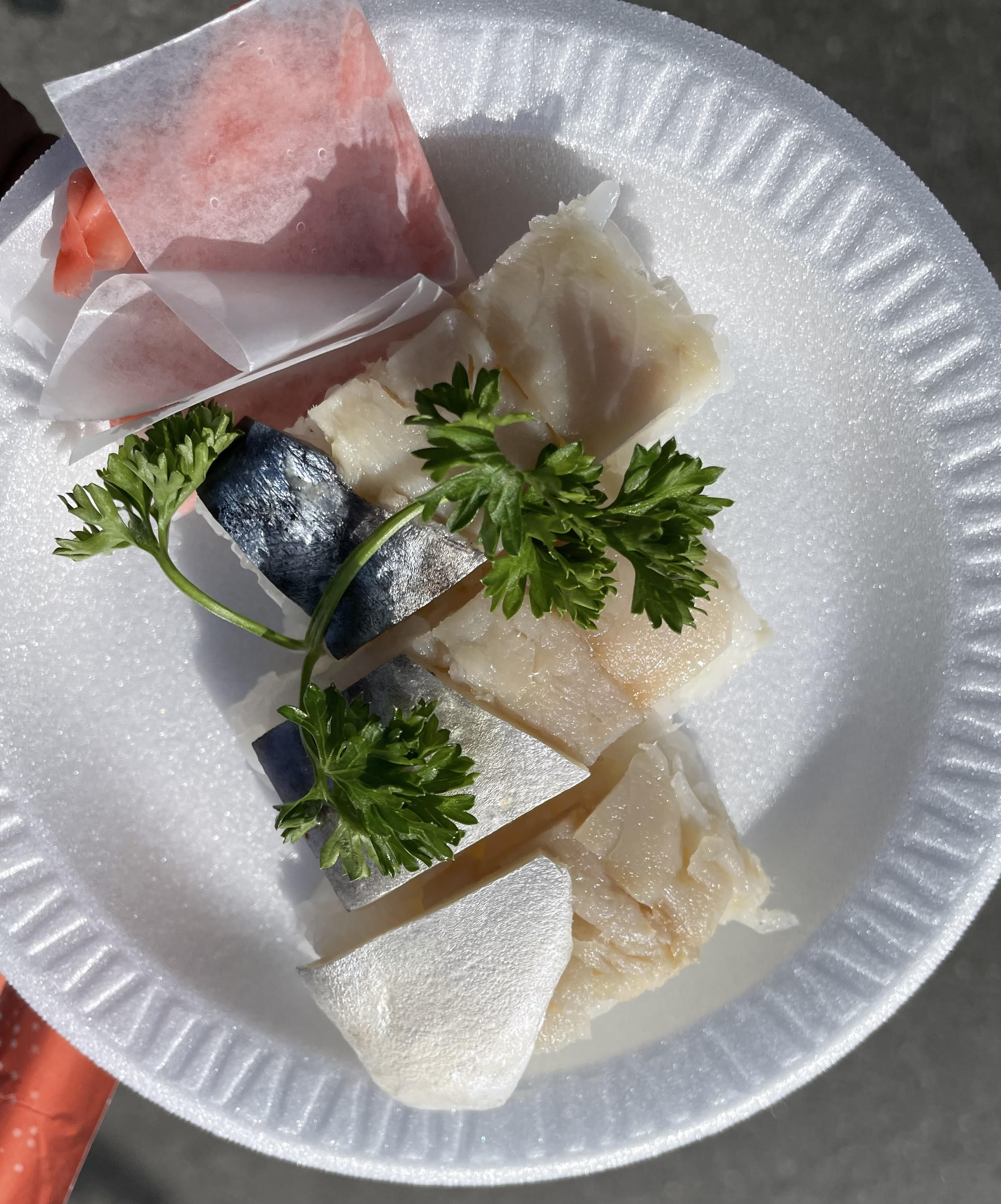
LA’s rich immigration history is woven into the fabric of its incredibly diverse culinary scene. Sakae Sushi is a beautiful reminder of resilience from hardworking immigrants, who not only faced the challenges of moving to a new country but also took the risk of starting a business in a time when sushi was still unheard of in the US.
“We don’t do any advertising, it’s pretty much word of mouth. We’re a little mom and pop, nothing fancy but we try to do what we do well. We try to make our grandparents proud,” Emi said to the LA Times.
The fact that Etsuko had been working at the shop years before I was born, or even before my parents crossed paths, is fascinating. The sushi stop is still going stronger than ever, selling out frequently for the day. The holidays are the busiest time for the Tani family, where it’s a common sight to see a line of people wrapping around the block.
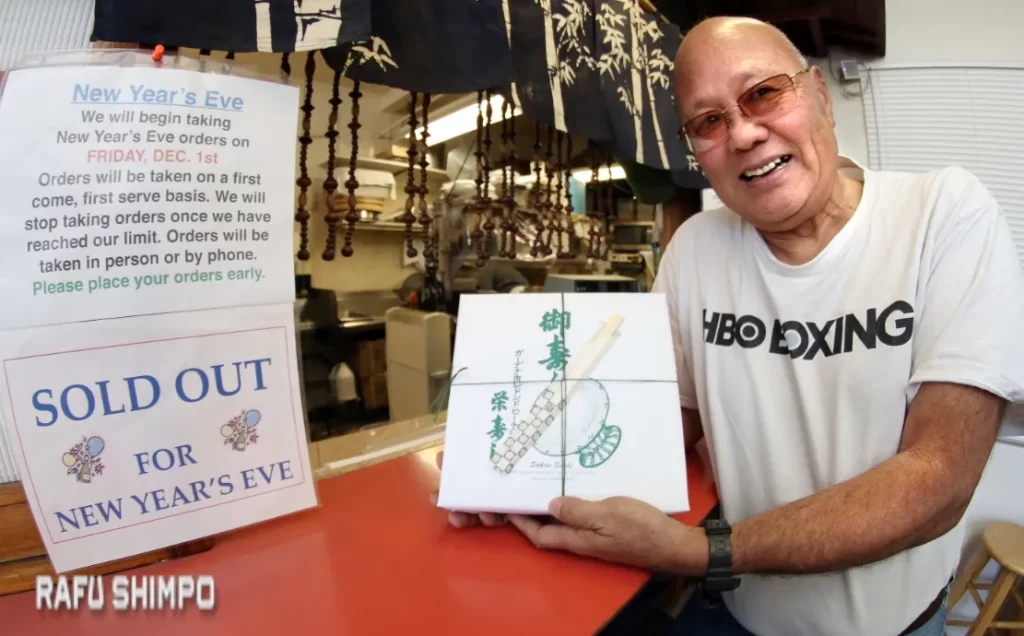
Will Sakae Sushi withstand another few decades? Etsuko is currently 82 years old and has no plans to stop. When the LA Times author asked if she still enjoyed working there after so many years, Etsuko replied: “Oh yeah — that’s why I’m here! You think I’d be here if I didn’t like it?”
Sakae Sushi: 1601 W Redondo Beach Blvd #112, Gardena, CA 90247
Hours: Wednesday – Sunday 9 AM – 4 PM
Phone: (310) 532-4550






What do you think?